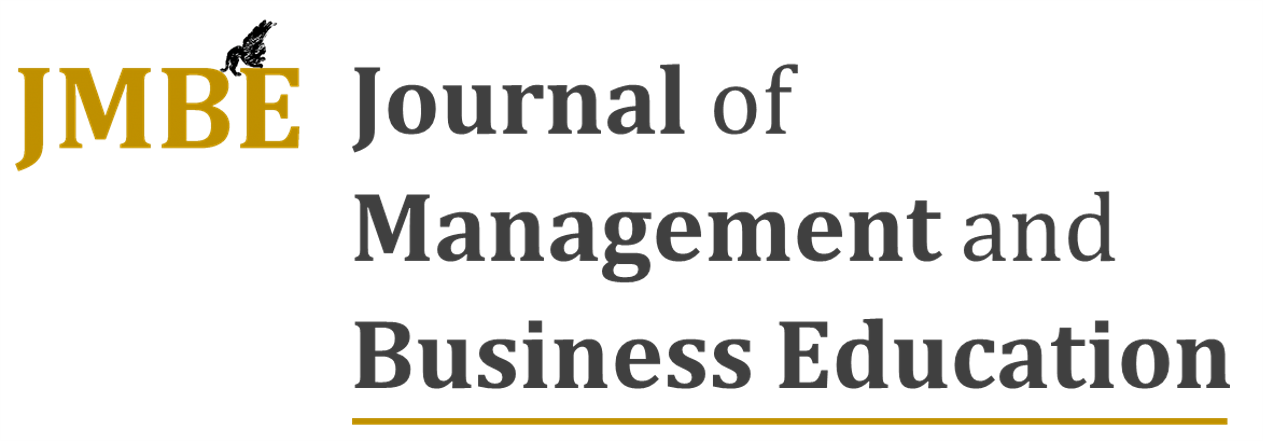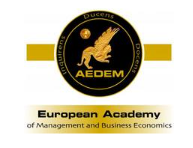Accounting students' perceptions on e-learning during the Covid- 19 pandemic: preliminary evidence from Saudi Arabia
DOI:
https://doi.org/10.35564/jmbe.2020.0015Keywords:
Saudi Arabia, E- learning, accounting students, accounting, emerging countriesAbstract
This study aims to discover accounting students’ opinions of e-learning, which was applied as an alternative to the traditional education system in Saudi universities during the Covid- 19 pandemic. This study is a cross-sectional survey that sought to collect field data on accounting students’ perceptions of e- learning in Saudi Arabia. The findings of the study revealed that the majority of the accounting students expressed that they did not benefit from e-learning, either in increasing flexibility in their study of accounting courses, facilitating their study of accounting courses, improving their communication with teachers, improving their communication with other students or improving their possibilities to solve problems connected to the study of accounting courses. The majority of students have agreed that the most important disadvantages of e-learning are: lack of human contact, the technical problems and too much dependence on computers. In general, this study contributes to the body of research on the benefits of e- learning in higher education. In particular, this study is the first study to evaluate the decision of the Ministry of Higher Education in Saudi Arabia to implement e-learning as a complete alternative to the traditional education system.
Downloads
References
Algahtani, A. (2011). Evaluating the effectiveness of the E-learning experience in some universities in Saudi Arabia from male students' perceptions, Durham theses, Durham University.
Aljawrneh, S. (2020). Reviewing and exploring innovative ubiquitous learning tools in higher education. Journal of Computing in Higher Education, 32(1), 57–73.https://doi.org/10.1007/s12528-019-09207-0
Alharbi, O. & Lally, V. (2017). Adoption of E- learning in Saudi Arabian university education: Three factors affecting educators. European Journal of Open Education and E-learning Studies, 2(2), 63-85.
Almarabeh, T. (2014). Students' perceptions of E-learning at the university of Jordan. International Journal of Emerging Technologies in Learning, 9(3), 31-35.
Ali, G. & Magalhaes, R. (2008). Barriers to implementing El-earning: a Kuwaiti case study. International Journal of Training and Development, 12(1),36–5.
Almosa, A. (2002). Use of computer in education. (2nd ed), Riyadh: Future Education Library.
Amer, T. (2007). E-learning and Education. Cairo: Dar Alshehab publication.
Arkorful, V. & Abaidoo, N. (2014). The role of e-Learning, the advantages and disadvantages of its adoption in higher education. International Journal of Education and Research, 2(3), 397-410.
Basak, S., Wotto, M., & Belanger, P. (2018). E-learning, M-learning and D-learning: Conceptual definition and comparative analysis. E-Learning and Digital Media, 15(4), 191-216. https://doi.org/10.1177/2042753018785180
Basioudis, I. & de Lange, P. (2009). An assessment of the learning benefits of using a web-based learning environment when teaching accounting. Advances in Accounting, 25(1), 13-19.https://doi.org/10.1016/j.adiac.2009.02.008
Bates, A. (2005). Technology, e-learning and distance education (2nd ed.). New York: Routledge.
Birch, D. & Volkov, M. (2007). Assessment of online reflections: engaging english second language (ESL) students. Australasian Journal of Educational Technology, 23(3), 291–306.https://doi.org/10.14742/ajet.1254
Boyle, T., Bradley, C., Chalk, P., Jones, R., & Pickard, P. (2003). Using blended learning to improve student success rates in learning to program. Journal of Educational Media, 28(2/3), 165–178.https://doi.org/10.1080/1358165032000153160
Buzzetto-More, M. (2008). Student perceptions of various E-Learning components. Interdisciplinary Journal of E-Learning and Learning Objects, 4(1), 113-134.https://doi.org/10.28945/370
Caporarello L., Manzoni B., & Bigi M. (2018). E-learning Effectiveness from a Students’ Perspective: An Empirical Study. Digital Technology and Organizational Change, 23(2), 163-172.https://doi.org/10.1007/978-3-319-62051-0_14
Delaney, D., McManus, L. & Ng, C. (2015). First Year Accounting Students' Perceptions of Blended Learning. Business Education & Accreditation, 7(2), 9-23.
Dowling, C., Godfrey, J. & Gyles N. (2003). Do hybrid flexible delivery teaching methods improve accounting students’ learning outcomes. Accounting Education: An International Journal, 12(4), 373-391.https://doi.org/10.1080/0963928032000154512
Du, C. (2011). A comparison of traditional and blended learning in introductory principles of accounting course. American Journal of Business Education, 4(9), 1-10.
Garrison, D. & Vaughan, N. (2008). Blended learning in higher education: framework, principles, and guidelines. San Francisco, CA: John Wiley & Sons.https://doi.org/10.5465/amle.7.1.31413871b
Hameed, S., Badii, A. & Cullen, A. (2008). Effective e-learning integration with traditional learning in a blended learning environment. European and Mediterranean conference on information system.
Herrador-Alcaide, T., Hernández-Solís, M. & Galván, R. (2019). Feelings of satisfaction in mature students of financial accounting in a virtual learning environment: an experience of measurement in higher education. International Journal of Educational Technology in Higher Education, 16(1), 1-19.https://doi.org/10.1186/s41239-019-0148-z
Keller, C. & Cernerud, L. (2002). Students’ Perceptions of E-learning in university education. Journal of Educational Media, 27(1/2), 55-67.https://doi.org/10.1080/0305498032000045458
Keller, J., Hassell, J., Webber, S. & Johnson, J. (2009). A comparison of academic performance in traditional and hybrid sections of introductory managerial accounting. Journal of Accounting Education, 27(3), 147-154.https://doi.org/10.1016/j.jaccedu.2010.03.001
Klein, D. & Ware, M. (2003). E-learning: new opportunities in continuing professional development. Learned publishing, 16(1), 34-46.https://doi.org/10.1087/095315103320995078
Liu, Y. & Wang, H. (2009). A comparative study on E-learning technologies and products: from the East to the West. Systems Research and Behavioral Science, 26(2), 191–209.https://doi.org/10.1002/sres.959
Love, N. & Fry, N. (2006). Accounting students' perceptions of a virtual learning environment: Springboard or safety net. Journal of Accounting Education, 15(2), 151-166.https://doi.org/10.1080/06939280600609201
Mastilak, C. (2012). First-day strategies for millennial students in introductory accounting courses: It's all fun and games until something gets learned. Journal of Education for Business, 87(1), 48-51.https://doi.org/10.1080/08832323.2011.557102
Mayes, T. (2002). Pedagogy, lifelong learning and ICT: A discussion paper for the Scottish forum on lifelong learning. Journal of Instructional Science and Technology, 5(1), 3-18.
Nor, A. & Kasim, N. (2015). Blended learning web tool usage among accounting students: A Malaysian perspective. Procedia Economics and Finance, 31(2), 170 – 185.https://doi.org/10.1016/s2212-5671(15)01144-2
Rooyen, A. (2015). Distance education accounting students’ perceptions of social media integration. Procedia - Social and Behavioral Sciences, 176, 444 – 450.https://doi.org/10.1016/j.sbspro.2015.01.495
Simonson, M., Smaldino, S., Albright, M. & Zvacek, S. (2012). Teaching and learning at a distance: foundations of distance education. (5th ed.). Boston, MA: Pearson Education, Inc.https://doi.org/10.1080/08923647.2011.589757
Smedley, J. (2010). Modelling the impact of knowledge management using technology. OR Insight, 23, 233–250.
Sun, P., Tsai, R., Finger, G., Chen, Y., & Yeh, D. (2008). What drives a successful e-learning? An empirical investigation of the critical factors influencing learner satisfaction. Computers and Education, 50(4), 1183-1202.https://doi.org/10.1016/j.compedu.2006.11.007
Trabulsi, R. (2018). Accounting students' attitudes towards traditional and modern teaching methods: the Saudi context. Academy of Accounting and Financial Studies Journal, 22(5), 1-6.
Tselios, N., Daskalakis, S., & Papadopoulou, M. (2011). Assessing the acceptance of a blended learning university course. Educational Technology and Society, 14(2), 224–235.
Van Raaij, E. & Schepers, J. (2008). The acceptance and use of a virtual learning environment in China. Computers and Education, 50(3), 838–852.https://doi.org/10.1016/j.compedu.2006.09.001
Wells, P., de Lange, P., & Fieger, P. (2008). Integrating a virtual learning environment into a second-year accounting course: determinants of overall student perception. Accounting and Finance, 48(3), 503-518.https://doi.org/10.1111/j.1467-629x.2007.00249.x
Wagner, N., Hassanein, K. & Head, M. (2008). Who is responsible for E-learning in higher education? A Stakeholders’ analysis. Educational Technology and Society, 11(3), 26-36.
Wondemetegegn, S. (2017). University Students' Perception and Utilization of Technology for Learning: The Case of Haramaya University. Journal of Teacher Education and Educators, 6(2), 139-156.
Zhang, D., Zhou, L., Briggs, R. & Nunamaker, J. (2006). Instructional video in e-learning: Assessing the impact of interactive video on learning effectiveness. Information and Management, 43(1), 15-27.https://doi.org/10.1016/j.im.2005.01.004
Downloads
Published
How to Cite
Issue
Section
License
Copyright (c) 2023 Journal of Management and Business Education

This work is licensed under a Creative Commons Attribution-NonCommercial-ShareAlike 4.0 International License.
License terms at: https://creativecommons.org/licenses/by-nc/4.0/legalcode




